Double-Sided Metasurface Array for a Dual-Band and Polarization-Independent Microwave-Energy-Harvesting System
Abstract
:1. Introduction
2. A Dual-Band and Polarized Unit Cell Design Methodology
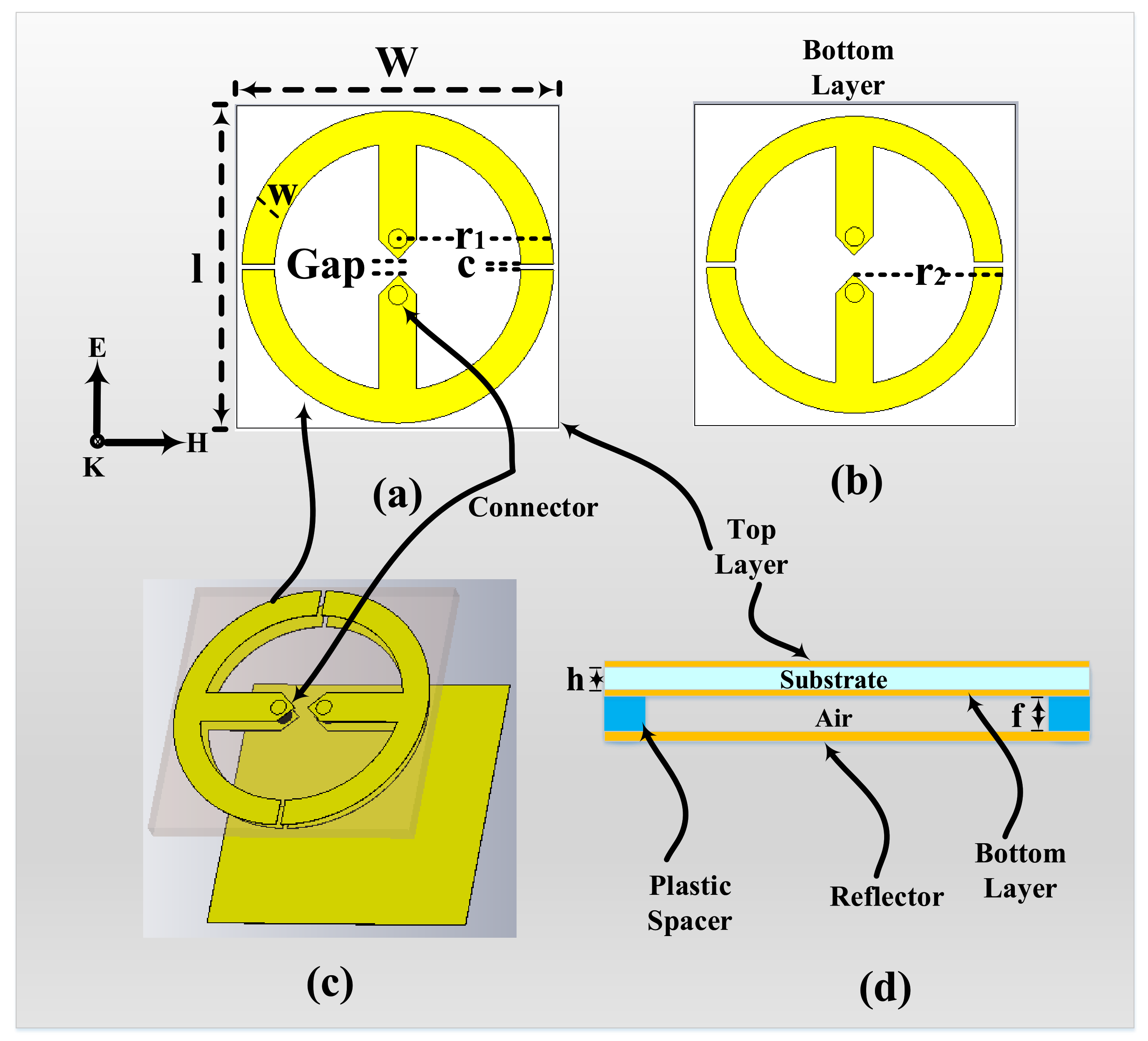
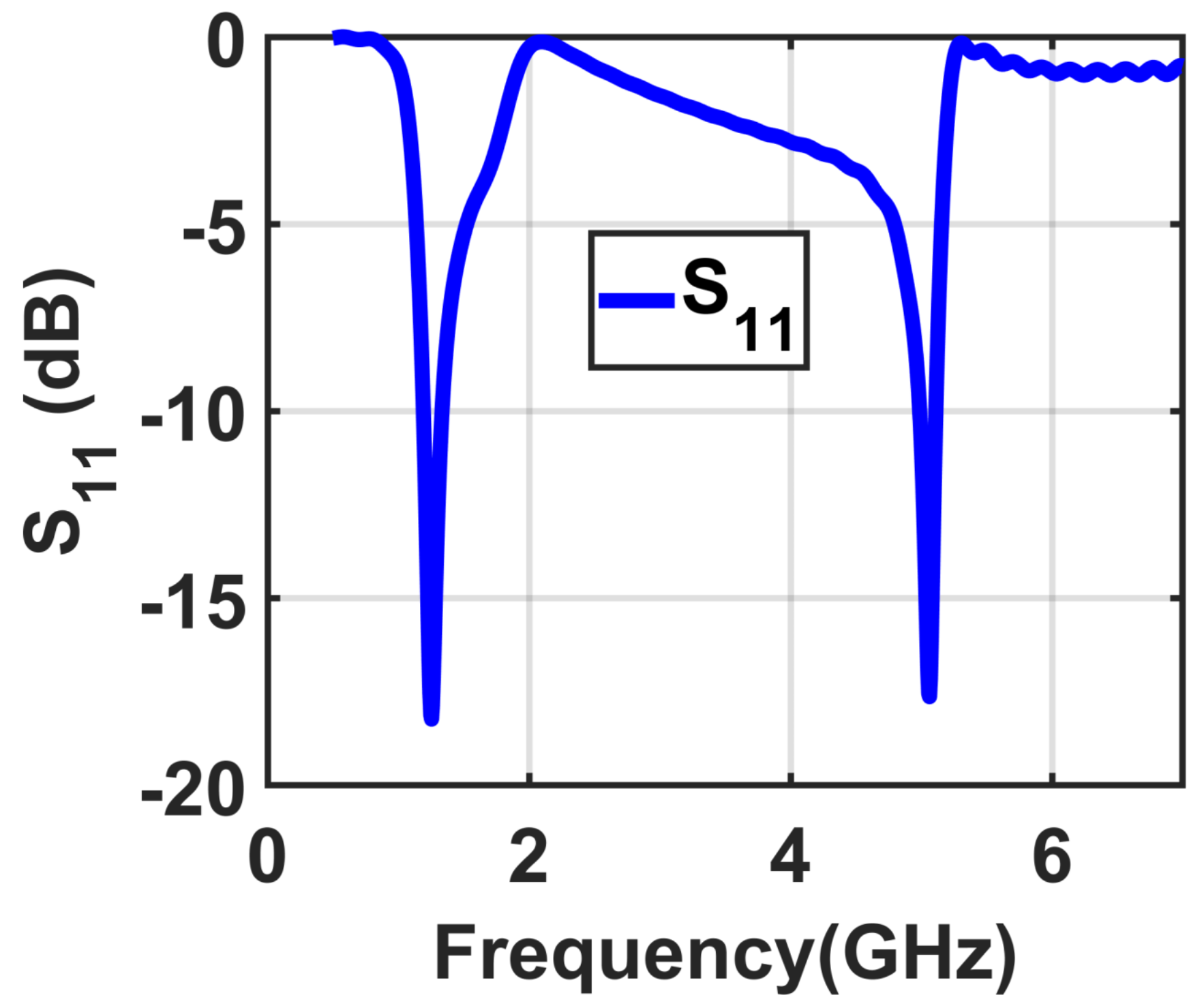
3. The 2 × 2 Supercell Design Methodology
4. The 8 × 8 Array Metasurface Design Methodology
5. Conclusions
Author Contributions
Funding
Institutional Review Board Statement
Informed Consent Statement
Data Availability Statement
Acknowledgments
Conflicts of Interest
References
- Amer, A.A.G.; Sapuan, S.Z.; Nasimuddin, N.; Alphones, A.; Zinal, N.B. A Comprehensive Review of Metasurface Structures Suitable for RF Energy Harvesting. IEEE Access 2020, 8, 76433–76452. [Google Scholar] [CrossRef]
- Bakkali, A.; Pelegrí-Sebastiá, J.; Sogorb, T.; Llario, V.; Bou-Escriva, A. A dual-band antenna for RF energy harvesting systems in wireless sensor networks. J. Sens. 2016, 2016. [Google Scholar] [CrossRef] [Green Version]
- Olgun, U.; Chen, C.C.; Volakis, J.L. Wireless power harvesting with planar rectennas for 2.45 GHz RFIDs. In Proceedings of the 2010 URSI International Symposium on Electromagnetic Theory, Berlin, Germany, 16–19 August 2010; IEEE: New York, NY, USA, 2010; pp. 329–331. [Google Scholar]
- Sarker, M.R.; Saad, M.H.M.; Olazagoitia, J.L.; Vinolas, J. Review of Power Converter Impact of Electromagnetic Energy Harvesting Circuits and Devices for Autonomous Sensor Applications. Electronics 2021, 10, 1108. [Google Scholar] [CrossRef]
- Shafique, K.; Khawaja, B.A.; Khurram, M.D.; Sibtain, S.M.; Siddiqui, Y.; Mustaqim, M.; Chattha, H.T.; Yang, X. Energy harvesting using a low-cost rectenna for Internet of Things (IoT) applications. IEEE Access 2018, 6, 30932–30941. [Google Scholar] [CrossRef]
- Ballo, A.; Bottaro, M.; Grasso, A.D. A Review of Power Management Integrated Circuits for Ultrasound-Based Energy Harvesting in Implantable Medical Devices. Appl. Sci. 2021, 11, 2487. [Google Scholar] [CrossRef]
- Awais, Q.; Jin, Y.; Chattha, H.T.; Jamil, M.; Qiang, H.; Khawaja, B.A. A compact rectenna system with high conversion efficiency for wireless energy harvesting. IEEE Access 2018, 6, 35857–35866. [Google Scholar] [CrossRef]
- Chen, Y.S.; Lai, F.P.; You, J.W. Analysis of antenna radiation characteristics using a hybrid ray tracing algorithm for indoor WiFi energy-harvesting rectennas. IEEE Access 2019, 7, 38833–38846. [Google Scholar] [CrossRef]
- Sun, H.; He, H.; Huang, J. Polarization-Insensitive Rectenna Arrays With Different Power Combining Strategies. IEEE Antennas Wirel. Propag. Lett. 2020, 19, 492–496. [Google Scholar] [CrossRef]
- Chai, J.; Cheng, J.; Zhang, D.; Xiong, Y.; Yang, X.; Ba, X.; Ullah, S.; Zheng, G.; Yan, M.; Cao, M. Enhancing electromagnetic wave absorption performance of Co3O4 nanoparticles functionalized MoS2 nanosheets. J. Alloy. Compd. 2020, 829, 154531. [Google Scholar] [CrossRef]
- Zhang, D.; Zhang, H.; Cheng, J.; Raza, H.; Liu, T.; Liu, B.; Ba, X.; Zheng, G.; Chen, G.; Cao, M. Customizing coaxial stacking VS 2 nanosheets for dual-band microwave absorption with superior performance in the C-and K u-bands. J. Mater. Chem. C 2020, 8, 5923–5933. [Google Scholar] [CrossRef]
- Alavikia, B.; Almoneef, T.S.; Ramahi, O.M. Complementary split ring resonator arrays for electromagnetic energy harvesting. Appl. Phys. Lett. 2015, 107, 033902. [Google Scholar] [CrossRef] [Green Version]
- Costanzo, S.; Venneri, F. Polarization-Insensitive Fractal Metamaterial Surface for Energy Harvesting in IoT Applications. Electronics 2020, 9, 959. [Google Scholar] [CrossRef]
- Zhang, X.; Li, L. A dual-band polarization-independent and wide-angle metasurface for electromagnetic power harvesting. In Proceedings of the 2017 Sixth Asia-Pacific Conference on Antennas and Propagation (APCAP), Xi’an, China, 16–19 October 2017; IEEE: New York, NY, USA, 2017; pp. 1–3. [Google Scholar]
- Li, L.; Zhang, X.; Song, C.; Huang, Y. Progress, challenges, and perspective on metasurfaces for ambient radio frequency energy harvesting. Appl. Phys. Lett. 2020, 116, 060501. [Google Scholar] [CrossRef]
- Aldhaeebi, M.A.; Almoneef, T.S. Planar Dual Polarized Metasurface Array for Microwave Energy Harvesting. Electronics 2020, 9, 1985. [Google Scholar] [CrossRef]
- Younesiraad, H.; Niksan, O.; Bemani, M. Highly-Efficient Double-Sided Dual-Band Polarization-Independent Metasurface Energy Harvester. In Proceedings of the 2020 28th Iranian Conference on Electrical Engineering (ICEE), Tabriz, Iran, 4–6 August 2020; IEEE: New York, NY, USA, 2020; pp. 1–4. [Google Scholar]
- Ayop, O.; Rahim, M.K.A.; Murad, N.A.; Samsuri, N.A. Double Layer Polarization Insensitive Metamaterial Absorber with Dual Resonances. In Theory and Applications of Applied Electromagnetics; Springer: Berlin/Heidelberg, Germany, 2015; pp. 231–238. [Google Scholar]
- Ghaderi, B.; Nayyeri, V.; Soleimani, M.; Ramahi, O.M. Pixelated metasurface for dual-band and multi-polarization electromagnetic energy harvesting. Sci. Rep. 2018, 8, 13227. [Google Scholar] [CrossRef]
- Almoneef, T.S.; Erkmen, F.; Ramahi, O.M. Harvesting the energy of multi-polarized electromagnetic waves. Sci. Rep. 2017, 7, 14656. [Google Scholar] [CrossRef] [Green Version]
- Yu, F.; Du, J.; Yang, X. Four-Band Polarization-Insensitive and Wide-Angle Metasurface with Simplified Structure for Harvesting Electromagnetic Energy. In Proceedings of the 2019 IEEE MTT-S International Wireless Symposium (IWS), Guangzhou, China, 19–22 May 2019; IEEE: New York, NY, USA, 2019; pp. 1–3. [Google Scholar]
- El Badawe, M.; Ramahi, O. Polarization independent metasurface energy harvester. In Proceedings of the 2016 IEEE 17th Annual Wireless and Microwave Technology Conference (WAMICON), Clearwater, FL, USA, 27–28 April 2016; IEEE: New York, NY, USA, 2016; pp. 1–3. [Google Scholar]
- Yu, F.; Yang, X.; Zhong, H.; Chu, C.; Gao, S. Polarization-insensitive wide-angle-reception metasurface with simplified structure for harvesting electromagnetic energy. Appl. Phys. Lett. 2018, 113, 123903. [Google Scholar] [CrossRef] [Green Version]
- Ashoor, A.Z.; Ramahi, O.M. Polarization-independent cross-dipole energy harvesting surface. IEEE Trans. Microw. Theory Tech. 2019, 67, 1130–1137. [Google Scholar] [CrossRef]
- Zhong, H.T.; Yang, X.X.; Song, X.T.; Guo, Z.Y.; Yu, F. Wideband metamaterial array with polarization-independent and wide incident angle for harvesting ambient electromagnetic energy and wireless power transfer. Appl. Phys. Lett. 2017, 111, 213902. [Google Scholar] [CrossRef]
- Xu, P.; Jiang, W.X. Dual-polarization metasurface for microwave energy harvesting. In Proceedings of the 2019 IEEE Asia-Pacific Microwave Conference (APMC), Singapore, 10–13 December 2019; IEEE: New York, NY, USA, 2019; pp. 989–990. [Google Scholar]
- Erkmen, F.; Ramahi, O.M. A Dual-band Electromagnetic Energy Harvesting Surface. In Proceedings of the 2019 IEEE International Symposium on Antennas and Propagation and USNC-URSI Radio Science Meeting, Atlanta, GA, USA, 7–12 July 2019; IEEE: New York, NY, USA, 2019; pp. 1157–1158. [Google Scholar]
- Chandrasekaran, K.T.; Agarwal, K.; Alphones, A.; Mittra, R.; Karim, M.F. Compact Dual-Band Metamaterial-Based High-Efficiency Rectenna: An Application for Ambient Electromagnetic Energy Harvesting. IEEE Antennas Propag. Mag. 2020, 62, 18–29. [Google Scholar] [CrossRef]
- Wang, X.; Zhao, Z.; Chen, K.; He, F.; Yuan, L.; Lu, T. Numerical studies on dual-band electromagnetic energy harvesting with double-ring split-ring resonators. In Proceedings of the 2015 50th International Universities Power Engineering Conference (UPEC), Stoke-on-Trent, UK, 1–4 September 2015; IEEE: New York, NY, USA, 2015; pp. 1–5. [Google Scholar]
- Mahfoudi, H.; Takhedmit, H.; Tellache, M. Dual-Band Dual-Polarized Stacked Rectenna for RF Energy Harvesting at 1.85 and 2.45 GHz. In Proceedings of the 12th European Conference on Antennas and Propagation (EuCAP 2018), London, UK, 9–13 April 2018; p. 4. [Google Scholar]
- Wang, J.; Yang, R.; Tian, J.; Chen, X.; Zhang, W. A dual-band absorber with wide-angle and polarization insensitivity. IEEE Antennas Wirel. Propag. Lett. 2018, 17, 1242–1246. [Google Scholar] [CrossRef]
- Ramya, S.; Srinivasa Rao, I. Design of polarization-insensitive dual-band metamaterial absorber. Prog. Electromagn. Res. 2016, 50, 23–31. [Google Scholar] [CrossRef] [Green Version]
- Zhang, X.; Liu, H.; Li, L. Tri-band miniaturized wide-angle and polarization-insensitive metasurface for ambient energy harvesting. Appl. Phys. Lett. 2017, 111, 071902. [Google Scholar] [CrossRef]
- Zhong, H.T.; Yang, X.X.; Tan, C.; Yu, K. Triple-band polarization-insensitive and wide-angle metamaterial array for electromagnetic energy harvesting. Appl. Phys. Lett. 2016, 109, 253904. [Google Scholar] [CrossRef]
- CST. Computer Simulation and Technology. Available online: http://www.CST.com (accessed on 7 May 2020).
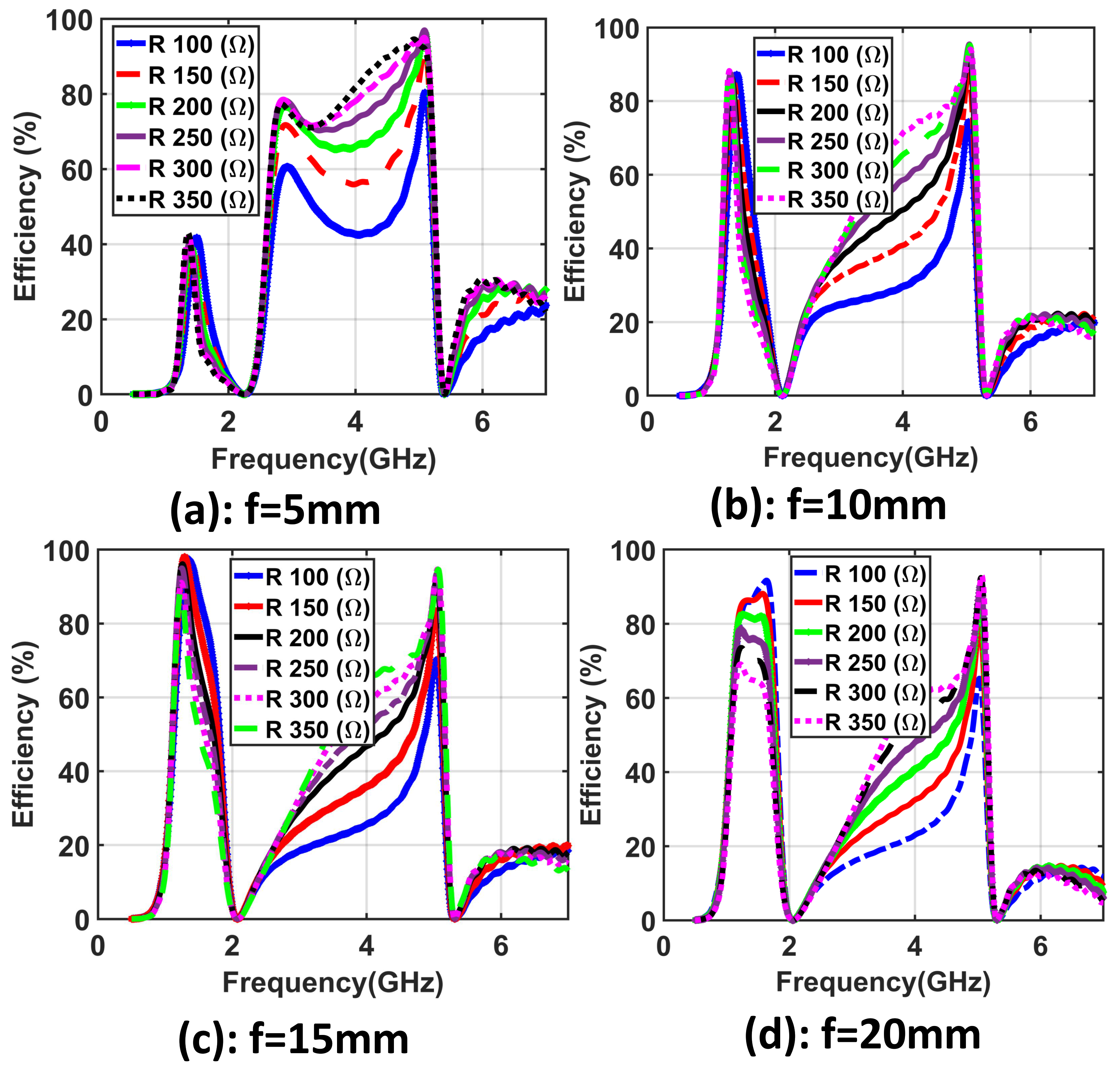
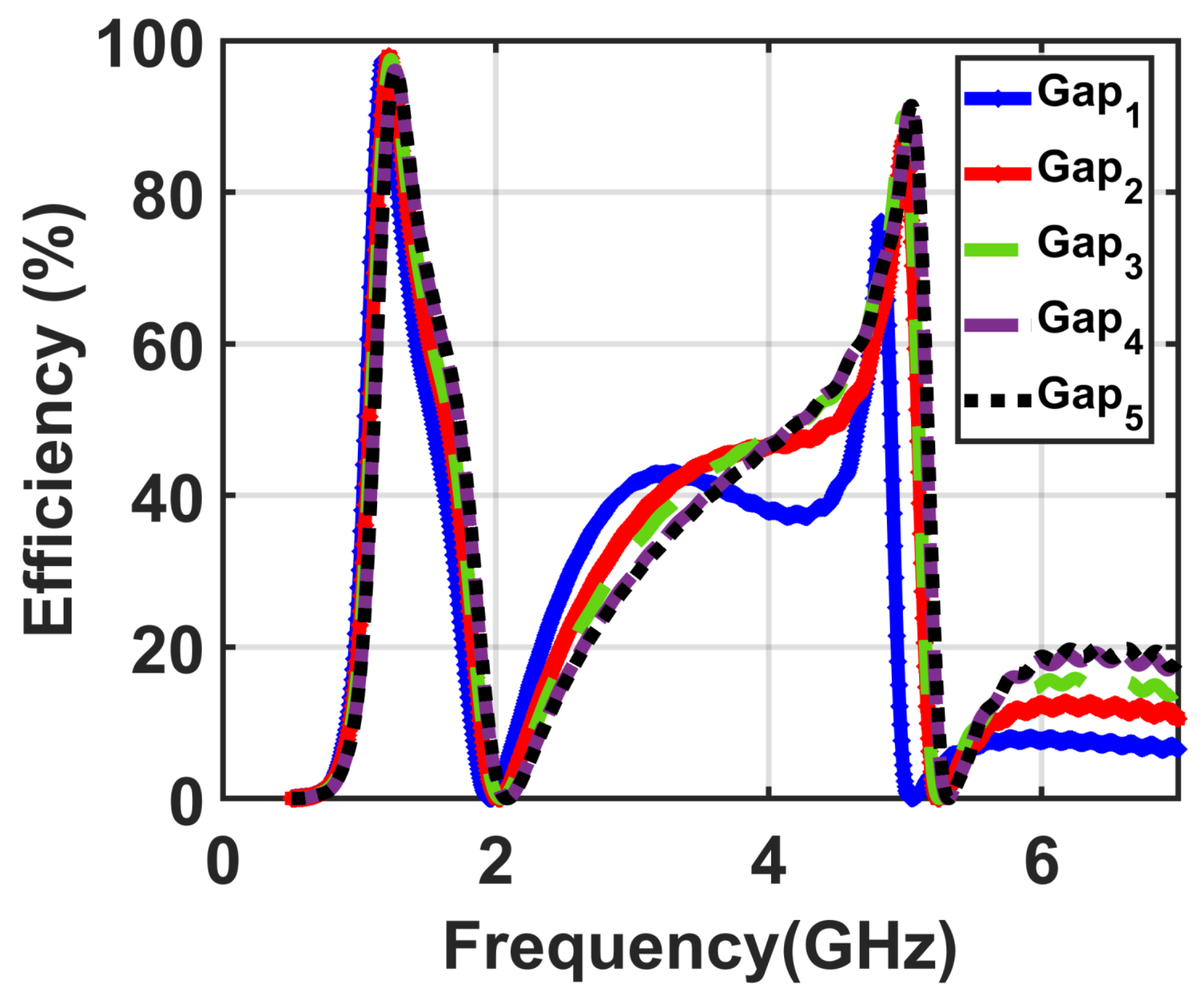

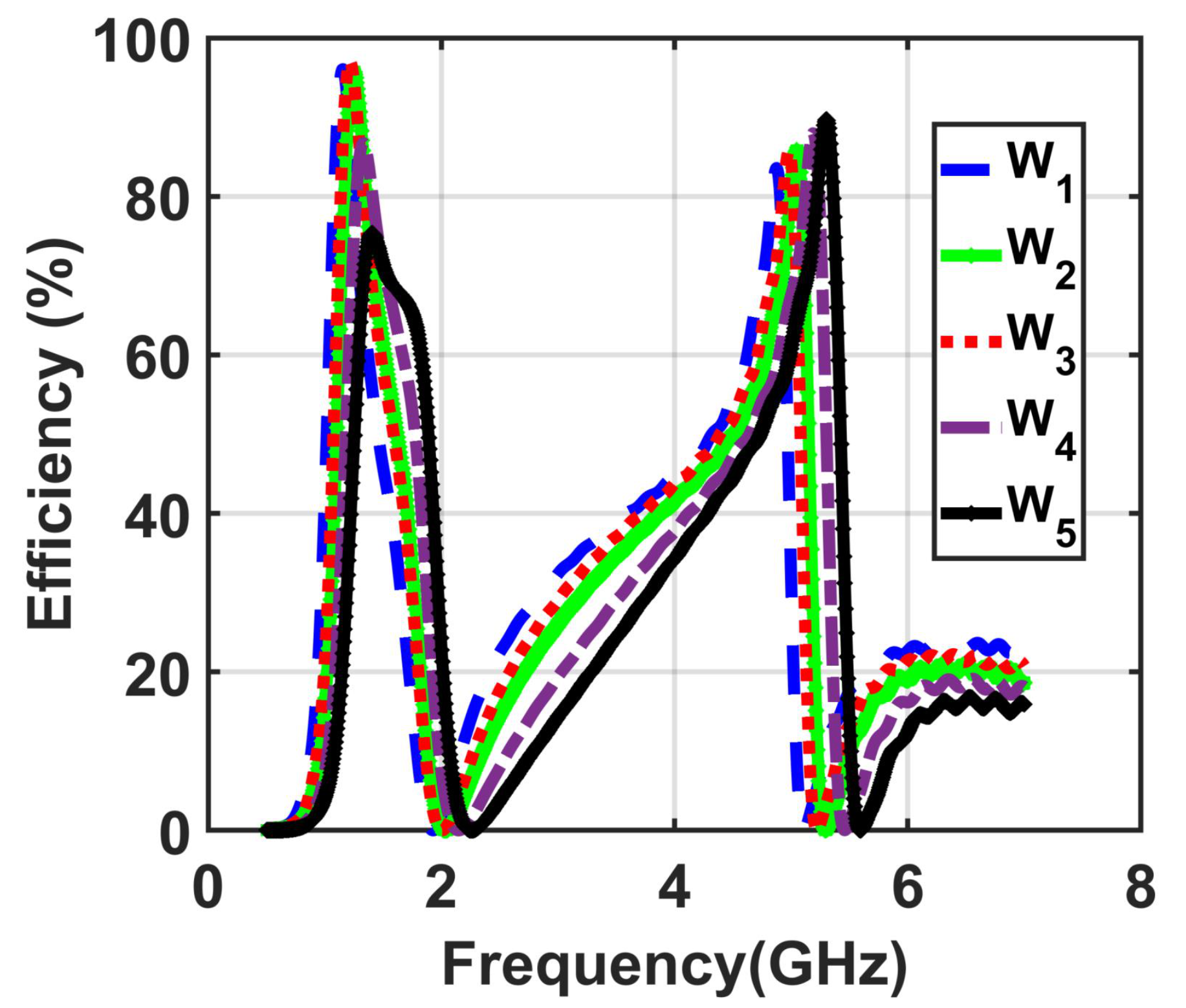


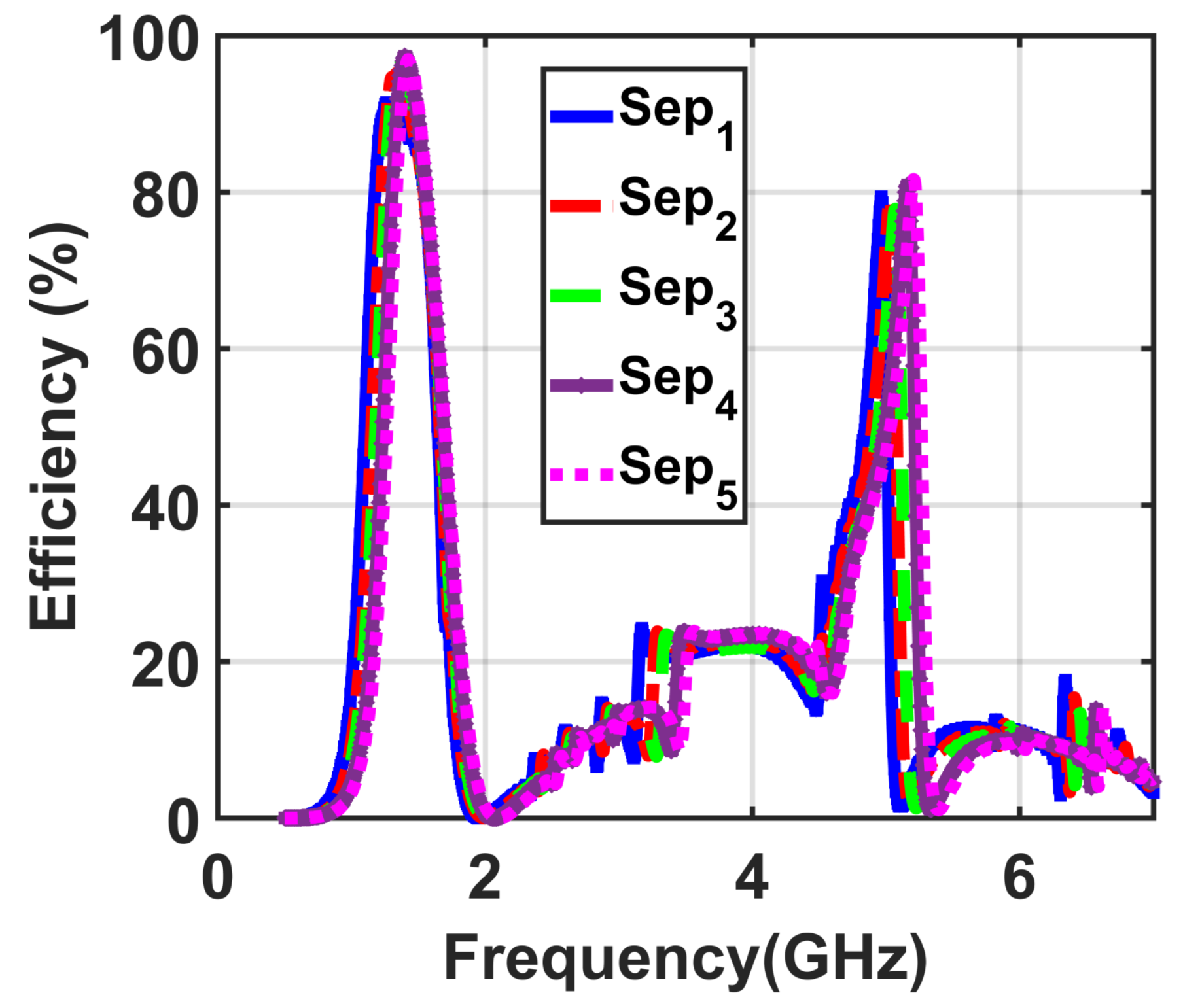

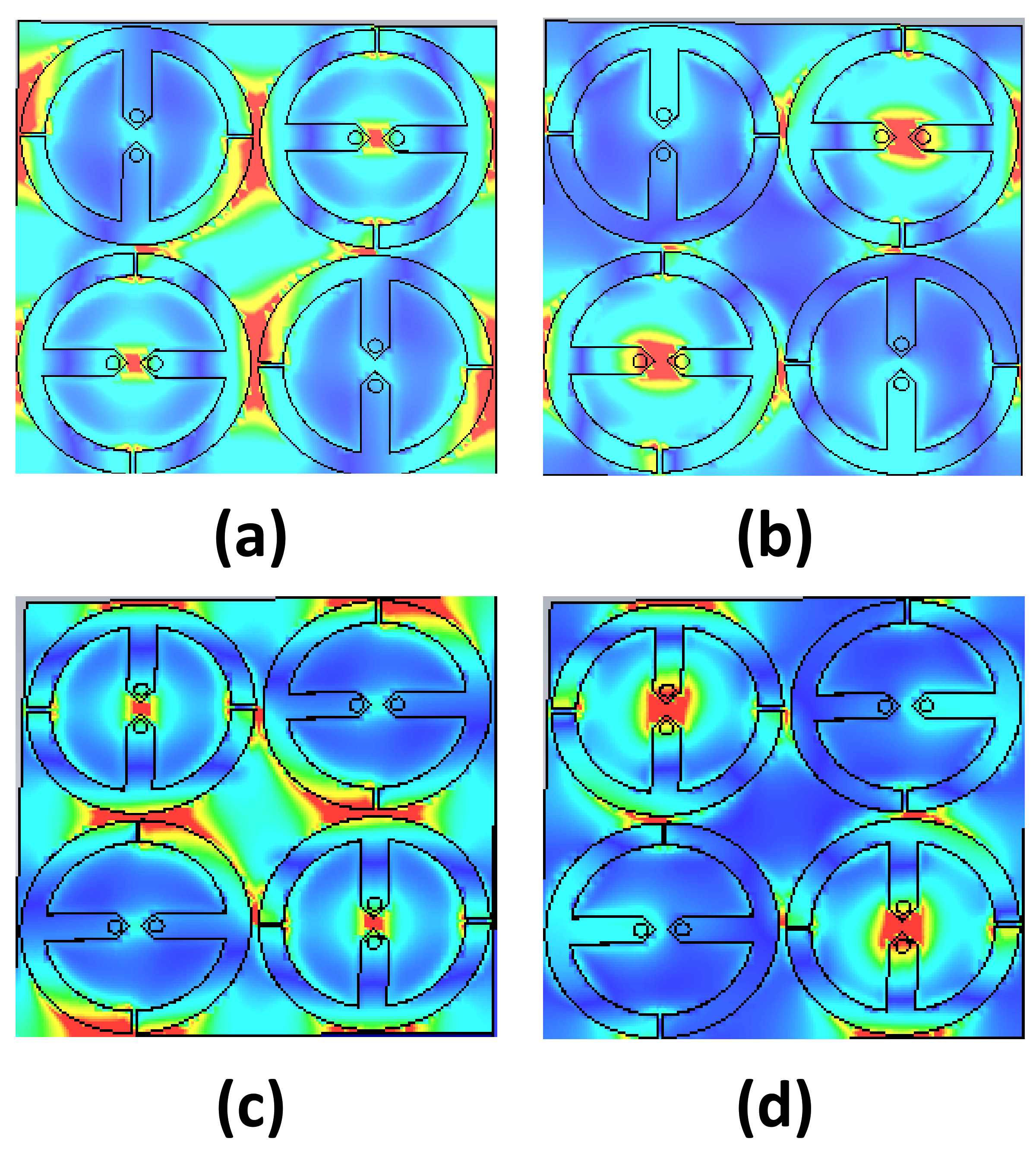
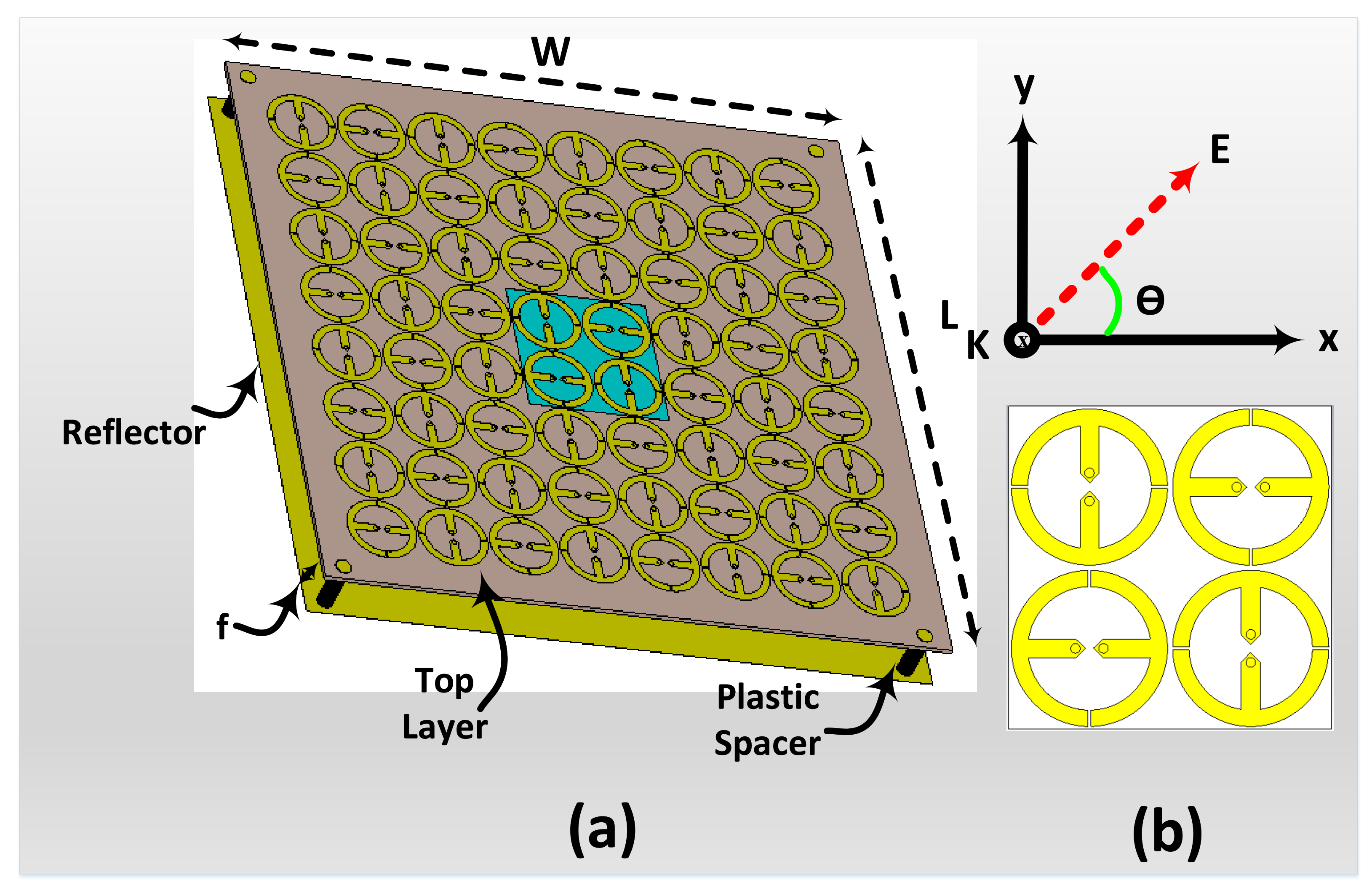
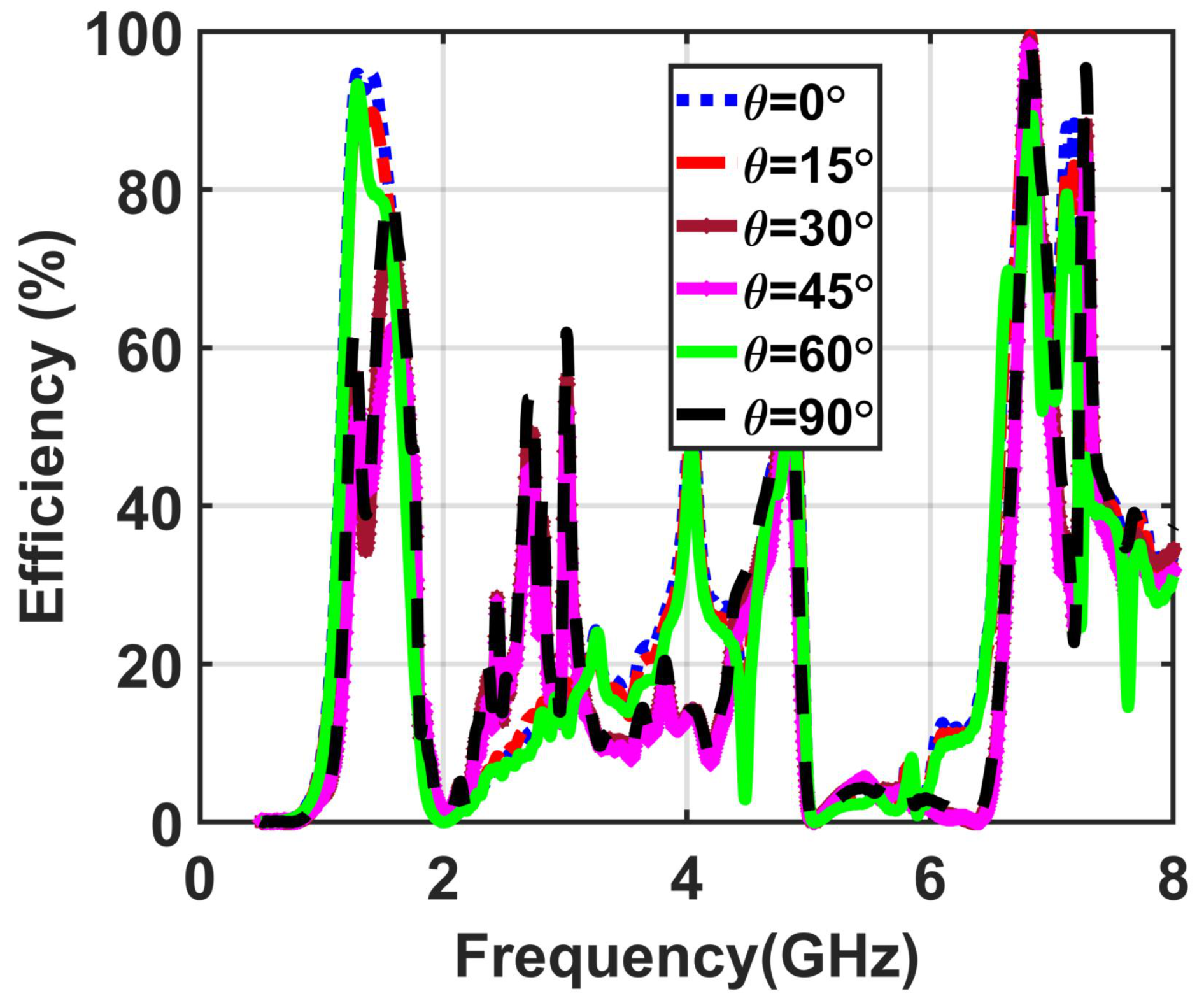
| Reference | Frequency Bands (GHz) | Unit Cell Size | Bandwidth of Matching Impedance | Need for Matching Network | Efficiency % |
|---|---|---|---|---|---|
| [17] | 5.5 and 7.2 | Narrowband | Yes | 94 and 93% | |
| [19] | 2.45 and 6 | Narrowband | Yes | 90 and 85% | |
| [30] | 1.85 and 2.45 | Narrowband | Yes | 47and 23 % | |
| [31] | 2.7 and 5 | Narrowband | Yes | 91 and 84 % | |
| [32] | 1.68 and 2.12 | Narrowband | Yes | 67 and 36 % | |
| This work | 1.8 and 6.5 | Wideband | NO | 98 and 95% |
Publisher’s Note: MDPI stays neutral with regard to jurisdictional claims in published maps and institutional affiliations. |
© 2021 by the authors. Licensee MDPI, Basel, Switzerland. This article is an open access article distributed under the terms and conditions of the Creative Commons Attribution (CC BY) license (https://creativecommons.org/licenses/by/4.0/).
Share and Cite
Aldhaeebi, M.A.; Almoneef, T.S. Double-Sided Metasurface Array for a Dual-Band and Polarization-Independent Microwave-Energy-Harvesting System. Materials 2021, 14, 6242. https://doi.org/10.3390/ma14216242
Aldhaeebi MA, Almoneef TS. Double-Sided Metasurface Array for a Dual-Band and Polarization-Independent Microwave-Energy-Harvesting System. Materials. 2021; 14(21):6242. https://doi.org/10.3390/ma14216242
Chicago/Turabian StyleAldhaeebi, Maged A., and Thamer S. Almoneef. 2021. "Double-Sided Metasurface Array for a Dual-Band and Polarization-Independent Microwave-Energy-Harvesting System" Materials 14, no. 21: 6242. https://doi.org/10.3390/ma14216242
APA StyleAldhaeebi, M. A., & Almoneef, T. S. (2021). Double-Sided Metasurface Array for a Dual-Band and Polarization-Independent Microwave-Energy-Harvesting System. Materials, 14(21), 6242. https://doi.org/10.3390/ma14216242






